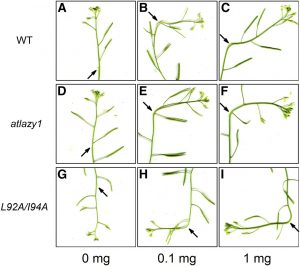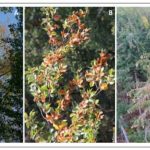How to Make a LAZY Plant Weep
The LAZY gene family, discovered through the characterization of a rice (Oryza sativa) mutant with unusually wide tiller angles, encodes proteins that  function in gravitropism. Gravitropism begins with a perception process that ultimately causes a difference in the cell elongation rate across the organ, stemming from the redistribution of the growth hormone auxin to the lower side of the organ. The perception event (i.e., the settling of statoliths is not affected in lazy mutants. Etiolated hypocotyls of an Arabidopsis (Arabidopsis thaliana) lazy quadruple mutant (atlazy1;2;3;4) are essentially agravitropic but display a robust phototropic response, which also depends on auxin redistribution. These and other results indicate that LAZY proteins function in a gravity-specific process downstream of statolith sedimentation but upstream of the auxin redistribution process. LAZY genes encode moderate-sized proteins with no known or predictable biochemical function. Yoshihara and Spalding (10.1104/pp.19.01144) have mutated each of 5 conserved regions of the AtLAZY gene and measured how well the transgenic expression of the resulting protein variant rescued the large inflorescence branch angle of an atlazy1 mutant. The most interesting results were found in region II where it was determined that two conservative amino acid substitutions (L92A/I94A) had the profound effect of switching shoot gravity responses from negative (upward bending) to positive (downward bending), resulting in a “weeping” inflorescence phenotype. Mechanical weakness of the stem was not the cause. Instead, the L92A/I94A change to AtLAZY1 reversed the auxin gradient normally established across stems by the gravity-sensing mechanism. This discovery opens up new avenues for studying how auxin gradients form across organs and new approaches for engineering plant architecture.
function in gravitropism. Gravitropism begins with a perception process that ultimately causes a difference in the cell elongation rate across the organ, stemming from the redistribution of the growth hormone auxin to the lower side of the organ. The perception event (i.e., the settling of statoliths is not affected in lazy mutants. Etiolated hypocotyls of an Arabidopsis (Arabidopsis thaliana) lazy quadruple mutant (atlazy1;2;3;4) are essentially agravitropic but display a robust phototropic response, which also depends on auxin redistribution. These and other results indicate that LAZY proteins function in a gravity-specific process downstream of statolith sedimentation but upstream of the auxin redistribution process. LAZY genes encode moderate-sized proteins with no known or predictable biochemical function. Yoshihara and Spalding (10.1104/pp.19.01144) have mutated each of 5 conserved regions of the AtLAZY gene and measured how well the transgenic expression of the resulting protein variant rescued the large inflorescence branch angle of an atlazy1 mutant. The most interesting results were found in region II where it was determined that two conservative amino acid substitutions (L92A/I94A) had the profound effect of switching shoot gravity responses from negative (upward bending) to positive (downward bending), resulting in a “weeping” inflorescence phenotype. Mechanical weakness of the stem was not the cause. Instead, the L92A/I94A change to AtLAZY1 reversed the auxin gradient normally established across stems by the gravity-sensing mechanism. This discovery opens up new avenues for studying how auxin gradients form across organs and new approaches for engineering plant architecture.



